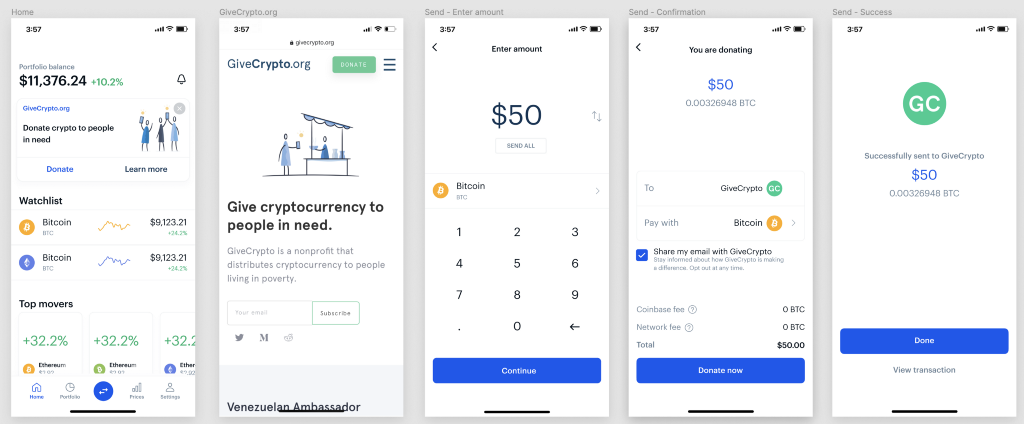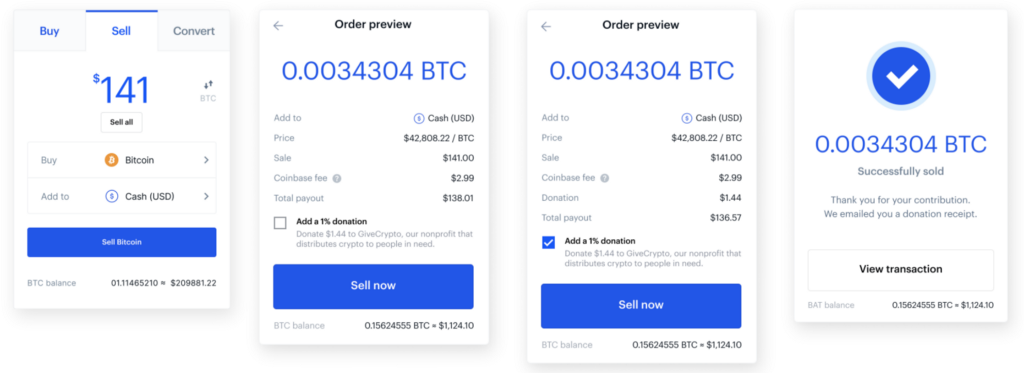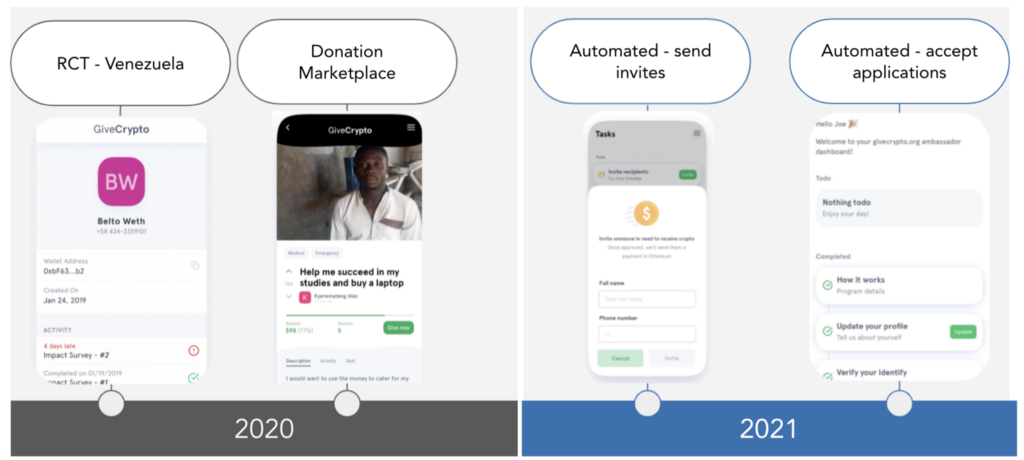Coinbase Integrations
As mentioned in previous updates, we’ve been experimenting with ways to make it as easy as possible for Coinbase users to donate to charity. Coinbase has over 68 million verified users, many of whom transact significant sums of crypto on a regular basis. We see a golden opportunity to facilitate charitable donations inside this ecosystem.

We have tried to integrate a donation function into Coinbase’s UI before, but we limited those past attempts to banners on Coinbase’s web and mobile properties. Those banners didn’t drive much traffic, and when they did, the user would have to go through a multi-step flow to donate. Because of that, donation volume has been relatively low.
Though these modest attempts weren’t the most effective, we chose to take this cautious approach for good reason: We wanted to be sure that we didn’t confuse users or impact Coinbase conversion rates. We also wanted to minimize the technical complexity of integrating a more prominent donation function until we and Coinbase were fully ready to do so.
We now understand that the real opportunity lies in integrating donation options into primary transactional flows like buy and sell. From integrating back-end services to solving a variety of other technical challenges, we know this won’t be simple. But finding a way for Coinbase users to seamlessly donate crypto would be a big accomplishment — not just for us, but also for the crypto community.

The current plan is to experiment with a ‘donate one percent of your transaction’ mechanic within Coinbase’s “sell” flow. At first, only a small percentage of Coinbase users will be exposed to this experiment as we observe how they impact key guardrail metrics. We’ll then analyze those results to determine our path forward.
As an aside, I’d like to take this opportunity to express how exciting it is to be involved in the innovation we’re witnessing in this industry. We have long believed that Coinbase has the potential to become a leader in the world of philanthropy, and our experience working together has only reinforced that belief. Perhaps one day we’ll be able to promote the verb “give” to a first-class citizen, so to speak, equal to the likes of “buy” and “sell.”
Ambassador Program
Before we give an update on the current status of the ambassador program, it probably makes sense to review the program’s history.

We launched the ambassador program in 2019 and spent the first half of 2020 implementing an RCT in Venezuela. We spent the second half of 2020 experimenting with a crypto donation marketplace that would be similar to GoFundMe or DonorsChoose but fully crypto-based. Ultimately, this didn’t accomplish what we hoped it would, so we decided to pivot back to the ambassador program in early 2021.
Our goal for 2021 was to automate as much of the program as possible so that it could be scaled in the near future. To minimize the manual workload, we started out by automating most of the program’s operational components, but we only invited people we felt we could trust. Giving away money on the internet tends to attract scammers, and we needed some assurances that people would use our funds in good faith.
We quickly learned that it would be hard to recruit ambassadors at scale if we only acquired them through high-trust channels such as labor marketplaces and social media networks. Once we realized that we would need to cast a wider net, we launched a version of the ambassador program that allows anybody to apply.
Before launching this updated version of the ambassador program, we developed fraud detection metrics designed to mitigate Sybil attacks. In simple terms, this helped us ensure that the ambassadors who applied to the program were who they said they were.
In the same update, we also tried to devise a trust score, which is a way of programmatically identifying which ambassadors are acting in good faith. We defined a good-faith ambassador as one who meets two criteria: they select recipients who are actually in need; and their recipients actually do what they say they’ll do with the funds.
Once we recruited a few hundred ambassadors, we found we needed to augment the automated scoring with significant manual investigation and intervention to thwart bad-faith behavior. We’ve thus realized that until our automations have undergone further maturation and validation, we’ll need to filter down the incoming audience.
For these reasons, we have decided to make the following changes:
Focus on the following countries: Venezuela, Colombia and El Salvador
Hire a manager in each country, whose primary job is to recruit trusted ambassadors. We will closely monitor these ambassadors and use the data to inform our automation process.
Monitor the activities of each ambassador’s recipients. We plan to give “good” ambassadors more invites and to extend the length of payment periods for “good”’ recipients.
Begin measuring the impact of donations via self-reported questionnaires and spot checks, which will be overseen by the local manager as well as high-quality ambassadors.
This revised approach will provide the following benefits.
Provide locations with different characteristics (i.e. inflation, crypto adoption, smartphone penetration and regulatory acceptance) but still have high levels of need and minimal logistical challenges (i.e. timezone and localization)
Reduce our team’s need to manually supervise the program
Improve the ratio of high-quality ambassadors signing up
Allow us to facilitate redemption options for recipients, such as stores and cash-out partners
Train and validate our data models on what good behavior looks like across various geographies
We have already started rolling out components of this plan and look forward to more enhancements in Q4. Between this program’s growth and the new donation options, we’re thrilled to see our work paying off.
was originally published in The Coinbase Blog on Medium, where people are continuing the conversation by highlighting and responding to this story.

